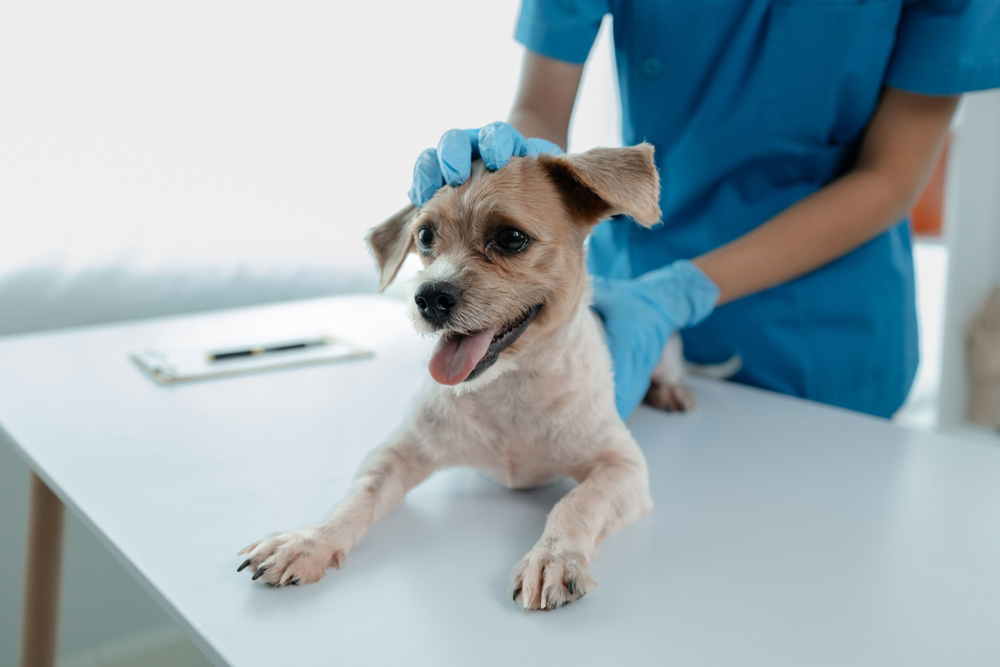Learning that a pet dog has cancer can be some of the most difficult news a dog owner can hear. Along with bearing emotional weight, dog owners often have to make difficult decisions about how to move forward with treating their dogs. In some cases, cancer treatment is available to help dogs recover. Dogs can develop different forms of cancer, and treatment plans will vary depending on the type of cancer they have.
Cancer treatment tends to be expensive and can range between a couple thousand dollars to $30,000. Therefore, it requires thoughtful budgeting and financial planning to complete a full round of cancer treatment for dogs. Fortunately, there are some resources available to offset some of the costs and help you budget for a dog’s cancer treatment.

Here’s What to Do
Finding a way to make cancer treatment more affordable often requires making multiple changes and drawing from different sources. Here are some things you can do to help pay for your dog’s cancer treatment costs.
1. Discuss Options With Your Veterinarian First

Make sure to have a detailed discussion with your veterinarian regarding your dog’s cancer diagnosis and treatment. It is important to ensure your dog’s quality of life is the treatment priority and that you’re not paying for anything that will do more harm than good.
Your veterinarian may be able to recommend more cost-efficient alternative or holistic cancer treatment options if they apply to your dog’s specific condition. Some veterinary clinics also offer payment plans and financial assistance options that help dog owners budget their dog’s cancer treatment costs.
If you’re concerned about your pet’s well-being, we recommend consulting a veterinarian.
If you need to speak with a vet but can't get to one, head over to PangoVet. It's an online service where you can talk to a vet online and get the personalized advice you need for your pet — all at an affordable price!
2. Research Pet Charities
Certain pet charities exist to help pet owners pay for veterinary care services. Start your search by looking up pet charities that offer financial assistance to cancer, such as Land of Pure Gold, the Riedel and Cody Fund, and the Joshua Louis Animal Cancer Foundation. Many dog owners have supported and received support from the Magic Bullet Fund, but this fund closed recently and stopped accepting donations as well.
Some states and local municipalities have programs that provide financial assistance for pet care. So, make sure to look up any local programs that might be able to help you pay for cancer treatments.
3. Rearrange Your Pet Budget

Consider making temporary rearrangements to your budget to help offset pet care costs. It is also helpful to look for ways to save on pet supplies. For example, you can save additional money by shopping from reputable discount pet supply shops and outlets. Websites like PetMeds and GoodRx often have deals for discounted pet medication.
Some pet stores have free membership perks, offer discounts for auto-shipping orders, and seasonal coupons. Staying on top of their deals and specials can help you save money in the long run and allocate more to paying for cancer treatments.
4. Explore CareCredit Accounts
CareCredit is a credit account that’s specifically for helping people pay for out-of-pocket healthcare costs, and veterinary care costs can be included as an eligible CareCredit expense.
CareCredit works like a regular credit card account where you can pay for cancer treatments without paying upfront with cash. One of its main benefits is that you may not have to pay interest as long as you pay back your balance within the creditor’s designated timeframe.
Just keep in mind that annual percentage rates (APR) can be high for CareCredit accounts. So, make sure that you’re able to make monthly payments on time before using CareCredit.
5. Crowdfunding

Setting up a crowdfunding campaign can help more people become aware of your dog’s cancer diagnosis and enable people to donate to their treatment fund. You can find several different crowdfunding sites that are specifically for fundraising for animals and pets. These sites often attract pet owners and animal lovers who understand the hardships of paying for expensive treatments. You can end up finding a great community that can support you and that you can support in return.
6. Look into Veterinary Colleges
If you live near a veterinary college campus, you may want to look into affordable care options that they may provide. Some veterinary colleges will offer lower costs for emergency care, and some may have cancer research programs or clinical trials. While your dog must meet a very specific set of requirements to be accepted in a clinical trial, it never hurts to ask and see if it is a viable option.

A Note on Pet Insurance

Pet insurance can help with budgeting and covering for veterinary care costs. However, pet insurance won’t help pay for any treatments related to pre-existing conditions. This means that pet insurance won’t cover your dog’s cancer treatment if your dog has already received a cancer diagnosis before you apply for an insurance plan.
Therefore, timing is key with pet insurance. Pet insurance can be particularly beneficial if your dog’s breed is genetically predisposed to cancer, such as German Shepherds and Golden Retrievers. If you’re interested in getting pet insurance for your dog, you’ll want to do it before your dog gets sick. Pet insurance companies will do a health background check and won’t cover cancer treatment if they find a cancer diagnosis.

Conclusion
Because cancer treatment for dogs is often a significant expense, it requires thoughtful consideration and planning. Paying for cancer treatment often requires exploring multiple avenues and rearranging your budget. It’s also important to maintain communication with your veterinarian so that you can make the best decisions for your dog and provide care that will preserve the highest quality of life for your dog.
Featured Image Credit: Pickadook, Shutterstock


















